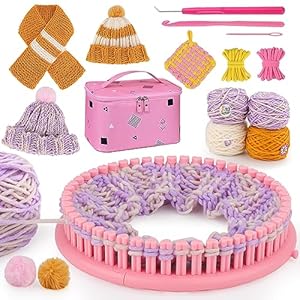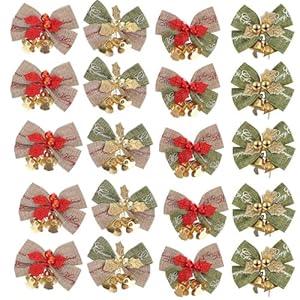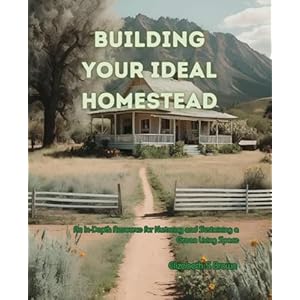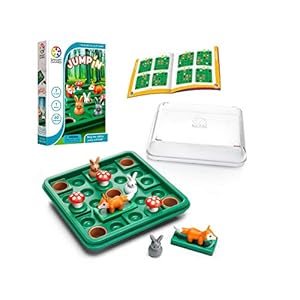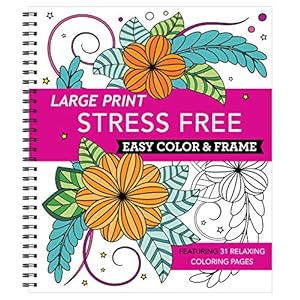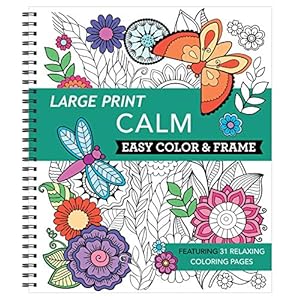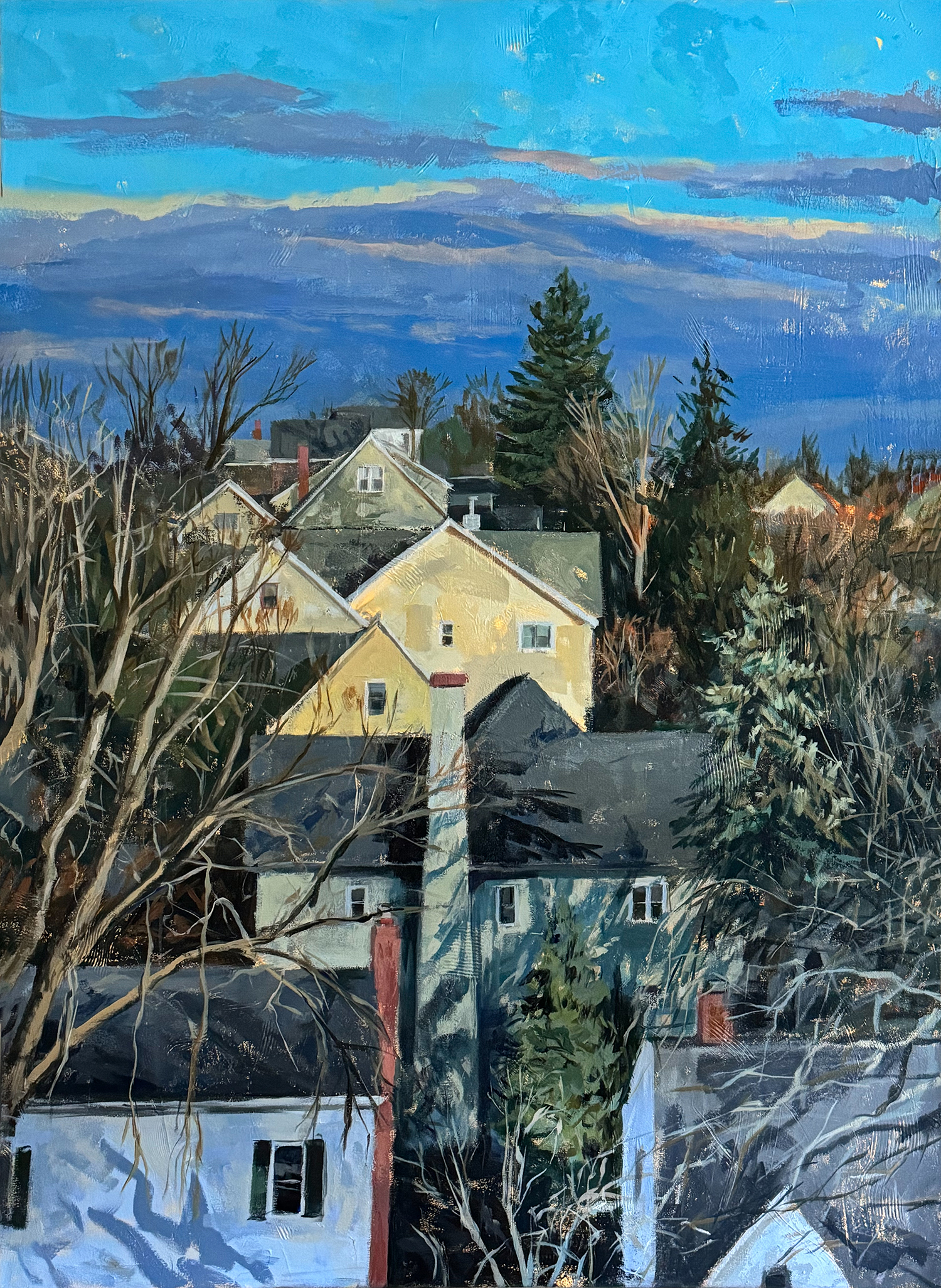
Susan Stillman won the Acrylic Award in Jackson’s Art Prize this year with her work Tangled. In this interview, she discusses working on 10 or more paintings at once, living a well-rounded life as an artist, and returning to the same subjects over and over with fresh eyes.
Above image: Studio portrait with October/Alexander

Tangled, 2024
Susan Stillman
Acrylic on canvas, 152 x 112 cm | 59.8 x 44 in
Josephine: Could you tell us about your artistic background?
Susan: As far as I can remember, I’ve always thought of myself as an artist. I studied anatomy as a 15-year-old with the master, Stephen Rogers Peck, and went on later to study with Robert Beverly Hale at the Arts Students League. Figure Drawing was my first love, and I still return to it to recharge and reengage my observational skills.
My high school art teacher, Dorrit Woolf, was responsible for my going to the Rhode Island School of Design for my BFA. After attending their summer program at age 16, I was sure it was the place for me. I chose Illustration as a major because it provided a rigorous foundation in drawing, and I also saw a path forward in supporting myself with my work.
The most influential experience from RISD was my junior year abroad in Rome with the European Honors Program. It was a seminal experience for me, seeing art in situ where it was designed to be seen. Art is woven into the fabric of everyday life there and Italy became my spiritual home.
When I graduated, I moved to New York City to pursue a career as a freelance illustrator. I supported myself in this way for about 10-15 years. Some of my most memorable jobs were illustrating a boxed, centennial edition of Joyce’s Ulysses, working with the author, Pete Hamill, to illustrate his book, Invisible City: A New York Sketchbook, and regular assignments for New York Magazine and The New York Times.
I always loved the dynamic of the classroom, and because I started teaching part-time at Parsons School of Design soon after graduating, I’ve essentially never left. Teaching has been a calling for me, never just a day job. The community of talented colleagues and my wonderful students continue to inspire and enrich my life and work.
I was always doing my own personal work between jobs, and in my early 30s, I took my MFA in painting at Brooklyn College, where the faculty was mostly made up of figurative artists. I studied with Lennart Anderson, Lois Dodd, and Philip Pearlstein, and I finally tackled painting, learning to see and mix colour. This was where I began my interest in the landscape. A driving trip in the UK was the source of my first body of work. I was looking at Fairfield Porter, Hopper, Diebenkorn, Jane Freilicher, and Wolf Kahn. I fell in love with the study of light and colour, pure form and abstraction.
At that time, I became very allergic to oil-based paints and started my long relationship with acrylic. I also started a commission business related to my personal work called ‘Home Portraits’. This helped support me for the next 30 years while I continued to pursue my personal painting when I had the time. Since 2020, I’ve been able to concentrate solely on my own work.

Studio view
Josephine: What does a typical working day in the studio look like for you? Do you have any important routines or rituals?
Susan: My studio is in the attic of my home, so I have a lot of flexibility in my day. I have a busy life, and I’m used to working in concentrated spurts of time. There are weeks when I am mostly stretching and preparing panels and canvases to be at the ready. There are weeks when I am starting many paintings at once, leaving them unfinished for long periods to get some distance and perspective. The beginnings are my favorite part of the process. Then, there are the weeks when I pick these back up and attempt to complete them without losing the spontaneity of the initial impulse. That’s the hardest part.

Work in Progress, Red Glow, 2025
Susan Stillman
Acrylic on canvas, 163 x 117 cm | 64 x 46 in
Josephine: Which materials or tools could you not live without?
Susan: I have learned many techniques to make working in acrylic easier. My Masterson Palette is used to store my paint, sometimes for weeks. Keeping it in the refrigerator helps prolong its freshness. A spray bottle of distilled water keeps the paint from drying and getting mouldy as I am working. I buy a lot of freezer paper to use for mixing colour, taping it to the pullout drawer on my worktable. I’ve used the same limited palette of colours for many years, which has forced me to learn how to mix almost every colour I need without having to waste money on unnecessary tubes of paint.

Painting palette, acrylic
Josephine: Do you work from a reference? What is your process?
Susan: I work in my studio and not from direct observation, so I rely on an extensive archive of photos that I am constantly shooting with my iPhone. I view these on the iPad I keep beside my easel, which is so much easier and cheaper than the years we had to make large prints to work from. These images jog my memory and give me a starting point to mine the thing that captured my interest in that particular moment. I don’t feel ‘married’ to the photos but use them as needed for information and structure. It’s been many years since I worked plein air, and the fugitive quality of the changing light makes the photo’s instantaneous capture the perfect method for my needs.

Painting wall, work in progress
Josephine: Do you regularly draw or keep a sketchbook? If so, how does this inform your work?
Susan: I kept sketchbooks for many years, using them for observational drawing and as a sort of diary for thoughts and ideas. I use them less these days. My paintings don’t start with drawings but are worked out on the canvas roughly with vine charcoal, as I initially cover the surface with large and quickly painted colour shapes.
I continue to fill many sketchbooks with figure studies that I draw when I’m teaching, and on my own during sessions with models.

Interwoven/St Ives UK, 2024
Susan Stillman
Acrylic on canvas, 152 x 112 cm | 60 x 44 in
Josephine: Have you ever had a period of stagnation in creativity? If so, what helped you overcome it?
Susan: Not so much a period of stagnation, as periods of time away from the studio. It could be family time, schoolwork, or preparing for shows. Even when I’m not at work, I am always aware and observant, looking for imagery and thinking about the work.
It’s always difficult to reenter the studio and find that focus needed to continue painting. I usually spend the first day back puttering, cleaning up, and getting things ready. By day two, I’ve picked up a painting in progress and can feel myself sliding back into the groove. I work on as many as 10 or more paintings at a time, visiting one for a bit before putting it away again when I’m unsure what to do next. Some distance is crucial in my process, with a goal of distilling the content to maintain the vitality of the first lay-in.

Attic studio view
Josephine: Are there any specific artists or mentors who have inspired you?
Susan: Lately, I’ve been thinking about Giorgio Morandi and the intimacy gained from repeatedly revisiting the same subjects in different configurations. With my series, ‘Peripheral Visions’, I am finding that intimacy in my own surroundings. I revisit these motifs and attempt to see them anew each time, with the heightened awareness of a traveller in a strange landscape.
I remember reading Ann Truitt’s trilogy, Daybook, Turn, Prospect, as a young woman. These journals chronicled her journey as an artist and a woman, balancing her creative work and family. The books lit a pathway for my own experiences and gave me confidence that I could enjoy the same well-rounded life as a fine artist.

Library detail
Josephine: What were you thinking about or exploring at the time you painted Tangled? What inspired it, and how did it come to be?
Susan: While I began painting with large canvases many years ago, it’s the small ones that have helped me to let go. I strive to retain the openness of the moment and not describe too much detail.
The painting that was shortlisted for the Jackson’s Art Prize in 2024, Walkway Over the Hudson, was a transitional painting for me. It brought the energy learned from my small Peripheral Visions panels into a more ambitious scale. Tangled is another step in that direction, using the high viewpoint I am so drawn to and referencing a familiar scene that I see repeatedly in all seasons and times of day. My daughter and son-in-law’s apartment has a spectacular view from their picture window on the fifth floor. I recognize the influence of Vuillard’s Place Vintimille, and all the artists who have been influenced by the aerial perspective of Japanese prints. There are many more paintings coming from this subject. I already have its companion started.

Walkway Over the Hudson, 2018
Susan Stillman
Acrylic on canvas, 163 x 117 cm | 64 x 46 in
Josephine: Why did this piece feel like the right one to submit?
Susan: Jackson’s Art Prize is one of the few open calls that allows large-scale works to be submitted. I took the opportunity to enter a more ambitious canvas because of that freedom. Tangled also represents the current direction of my work, an exploration of light and time expressed through a dynamic range of elements.

Studio view, works in progress
Josephine: How did it feel to realise you had won the Acrylic Award?
Susan: I was so excited to follow as the different stages were rolled out! The number of entries and the high quality of work make this competition especially significant in the landscape of open calls. I was thrilled and honoured to be shortlisted again, and then to get the Materials Award! I received the email telling me about the award in the morning, and that afternoon, I got word that I’d won the Distinguished Teaching Award at The New School/Parsons School of Design, where I’ve been a faculty member for 42 years. It was a stellar day and the most remarkable validation for my life choices as both an artist and an educator.

Studio still life
Josephine: How do you think about scale in your work, and how does it influence the way you frame a scene or guide the viewer’s experience?
Susan: The scale of the work has an impact on how the images are perceived, as larger paintings invite the viewer to enter the space created, and smaller-scale work feels fragmentary, echoing my experiences of moving through the landscape and noticing flashes of colour on the periphery.

Work in progress
Josephine: How has your relationship to your daily routines, everyday environments and observations informed the development of your work both conceptually and visually?
Susan: The landscape I see every day shapes my work. It’s a foundation from which to explore the relationships between the natural to the man-made architectural elements. The views from my windows high on the hill, and my daily walks in all seasons, feed my preoccupation with light and the way it affects change in colour and tonalities. The simplicity of the subject is transformed by the moment of illumination and by our unexpected attention. Many of the motifs I’ve painted have been revisited repeatedly in different times of day, seasons, weather, and in various scales. My greatest takeaway from this intense and intimate study is that every moment is entirely unique, and repetition only enhances this understanding.

Attic studio/office
Josephine: Are there any new materials or ideas you’re excited to explore using your prize?
Susan: I have enough paint here to carry through many years! I’ve added a few colours to my chosen palette, but I keep things straightforward by using just a warm and cool version of each hue, forcing me to understand the components of colour and reproduce them without relying on too many choices.

Studio portrait with Tangled
Josephine: What’s coming up next for you?
Susan: I’m excited to get back into the studio. It’s been a fruitful and busy summer showing my work, but the painting beginnings I left for myself are calling, like crumbs in the forest to help me find my way back. I can’t wait to break open the new paint!
Further Reading
Meet Eleanor Johnson, Winner of Jackson’s Art Prize 2025
Jackson’s Art Prize 2025 Exhibition at Affordable Art Fair
How We Collaborate With Artists
Expert Advice on Making Your Way as an Artist
Shop Acrylic Painting on jacksonsart.com
The post Susan Stillman: A Moment of Illumination appeared first on Jackson's Art Blog.
Trending Products






